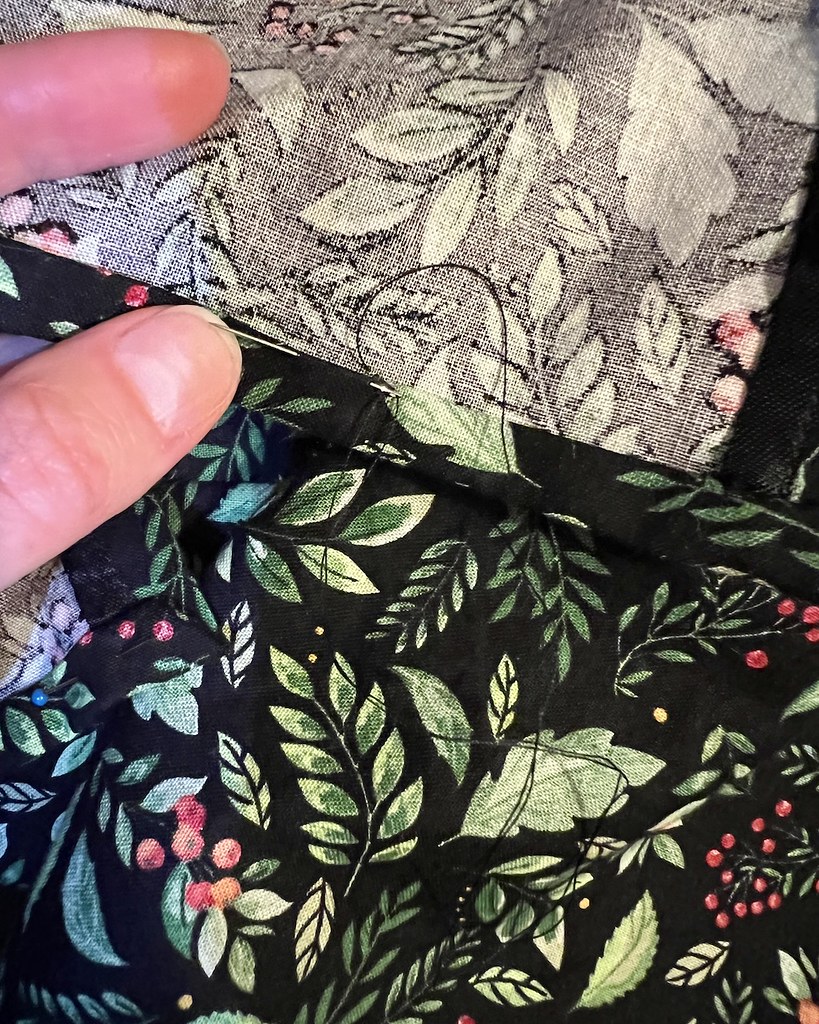I managed to finish my Christmas frock with plenty of time to spare, so it seemed like the perfect opportunity to make another holiday themed item. Vogue 1863 came out earlier this year, and I was very excited to see another vintage reproduction released with some lovely details.
The collared blouse takes quite a bit of yardage, which I only realized after deciding that it was the pattern that I had my heart set on making. Fortunately, I had enough of this berry print stashed away with my Christmas cottons, which seemed like a sign that they were meant to be paired together.
I haven't make a black floral print in some time, and I really do love them. And this is a reminder to myself that I need to restock my black interfacing stock. I had to piece the facing in order to get everything cut out of my scraps.
I also noted a drafting problem with this particular view. The diagonal dart is supposed to be ironed down, not up (which is standard). But as you can see, the cutouts for the pattern do not allow for the dart to be folded down, but instead, it must be folded up. It's not a huge deal, just slightly aggravating, and not something I would think to check on a Vogue pattern.
My favorite method for clipping into corners is to face them with a scrap of silk organza. This is commonly used for underarm gussets, but it also comes in handy at other moments. In this case, the collar calls for two cuts to be made at the center back in order to attach it to the neckline.
This gives a nice clean corner without having to worry about raw edges extending beyond a line of stitching (which is what this pattern suggests, and is the most common technique that I see).
All raw edges were finished with rayon seam binding, which I'm sure comes as no surprise to anyone who has followed me on this blog for an length of time!
This is the only blouse that I have made or possibly even seen that is double breasted. I love a double breasted suit jacket, so I decided that this would be a fun thing to try with a blouse.
And, of course, one of the best things about this design is the cuffs.
There is a fair amount of bulk between the double layered cuff, the knot, and the facing, so this pattern is going to work best with a textile that is not too thick. Or maybe you could get away with substituting a thinner facing material . . . because I think this would be really lovely in wool.
Although not suggested by the pattern, I reinforced the places where the buttons/snaps were going to be stitched on the bodice front.
And the hemline and side seam slits were hand stitched instead of the suggested top-stitching. The only alteration I made to this pattern was to eliminate a wedge from the back bodice, which is standard for me. I did not bother to extend the torso length because I didn't think it would be necessary. If I make this again, I would probably lower the opening slits at the side seams. As the are drafted, the slits are just covered by a skirt waistband. I could go back and change this, but I probably won't! It works as-is, and I am not a fan of mending - in fact, I will do just about anything to avoid it.
One other addition that I made was a scrap of fabric placed at the back of the snaps. The interfacing was probably enough stability, but I don't want the snaps to pull too hard on the mid-weight cotton.
This double breasted design utilizes two buttonholes and two snaps which are then covered with buttons. I suspect that the reason that this design is constructed with snaps is because the instructions have you make bound buttonholes. The best method for finishing the interior of a bound buttonhole is to cover it with a facing. But since two of the four buttons are placed outside of the facing (hello, double breasted design) that is not possible, so they have substituted snaps. Interestingly enough, the instructions suggest finishing the square of fabric that binds the bound buttonhole. I was confused by the instruction, but now I am wondering if the original vintage design or Vogue was going to suggest making four bound buttonholes instead of two. That would mean that two of the four buttonholes would be exposed on the interior of the garment, and therefore would need to have finished edges.
Here is my attempt to show those pretty cuffs. The dark fabric and the overcast Winter weather make it difficult to see, but they really are lovely. The knot seems like it could be slightly shorter, but I do like the gentle drape of the cuff with the extra room.
I was excited about this pattern as soon as I saw it, and it hasn't let me down now that I have made my own version. The other blouse included with this design has also caught my attention, and that skirt is gorgeous, as well. And I wouldn't put it past me to make another version of this exact blouse. Maybe I can even stomach a solid colored fabric if I am making such a lovely design.
But I will definitely enjoy wearing this blouse! It's a keeper.



















Your sewing skill and attention to detail is beautiful to see! Thank you for sharing your journey of sewing! I am a fan!
ReplyDelete